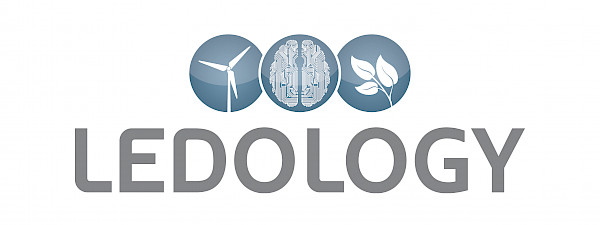LEDOLOGY
Dynamic LED lighting according to LEDOLOGY
Climate change. Crumbling biodiversity. Resource depletion. Concerns that call for global action. But as a lighting manufacturer, we also like to do our bit for a sustainable world. By innovating and creating solutions that reduce energy consumption and eliminate waste. To this end, HBI Bisscheroux has developed a pioneering lighting concept: LEDOLOGY.

The power of LEDOLOGY
The strength of LEDOLOGY lies in combining intelligence with high-quality and highly durable materials. An electronic driver controls a high-quality LED light source. To this, we can add all kinds of functionalities. Think of a light & motion sensor, emergency lighting whether or not monitored wirelessly via LoRa in Sqippa-online.
Long lifespan
Just one microchip controls all these functions. As a result, the sensors work together smartly and efficiently. Moreover, it eliminates the need for moving parts (such as a relay). All this extends the lifetime of the luminaire. LEDOLOGY luminaires last at least 70,000 hours, often even more than 100,000 hours. These luminaires also come with a 5-year guarantee. LEDOLOGY luminaires are ideal for lighting corridors, galleries, porches, entrances, stairwells, basements and bicycle sheds.
Two light levels
A LEDOLOGY luminaire fitted with a light and motion sensor decides for itself when to switch on or off and illuminates at two lighting levels: at an economical low level and a high level. For parking garages, there is even a 3rd lighting level; medium level (50%).
Low level
At low level, the lighting is operated at a dimmed level of 20%; a safe basic lighting level. The human eye is very insensitive and experiences low level not as 20% but as 50% or 60%, for example. As soon as the light sensor detects an illuminance of less than 100lux, the luminaire is dimmed to low level at the default setting. The luminaire then consumes very little energy. Thanks to the low heat development, LEDs and electronics last extra long. Low level can also be switched off (0%) with a dip switch in the luminaire. The luminaire then only lights up when it is dark and when the motion sensor detects movement.
High level
Does someone move near the luminaire? Then the lighting switches gently up to high level (adjustable to 100%, 80%, 60%, 40%). If the sensor detects no movement for 30 seconds, the lighting switches back to low level. Each luminaire operates independently. Where there is plenty of daylight, the lighting is switched off during the day. In dark places, the lights stay on, dimmed or not. This is the best way to save energy while maintaining safety and comfort for residents or visitors.
Alternative
Do you have luminaires without a built-in light & motion sensor? Then you can still make use of the two light levels by connecting voltage to L1/N (low level) and L1+L2/N (high level). Example: connect an external twilight switch to L1 and an external passive infrared sensor (PIR) to L2. The luminaire lights at low level (20%) when it is dark and switches to high level when the sensor detects movement. Low level is usually more than sufficient to illuminate an emergency pictogram luminaire.
Motion sensor sensitivity
The motion sensor in a fixture - the radar - emits radio waves at a frequency of 5.8GHz. When movement occurs, the reception pattern changes. The microcontroller adjusts the lighting level digitally accordingly, without the need for a relay. The motion sensor signals movement up to a distance of up to 10 metres. The range of this sensor can fluctuate. This depends on site conditions (jammers) and the size and speed of a moving object. The radar can 'see' through materials such as stone, concrete, glass and plastic to a limited extent. To assess whether and in what cases luminaires with a motion sensor switch up undesirably, we recommend testing on site beforehand. Unwanted switching cannot always be prevented. We recommend being very cautious when turning off low level (from 20% to 0%) to save extra energy. Firstly, it creates a turbulent lighting image, where dangerous situations can arise if residents or visitors have to take steps into a dark room before they are seen by a motion sensor. Secondly, energy consumption at low level 20% is already so low that the energy savings to be made will be limited. In stairwells, we recommend keeping the default setting - low level 20% - everywhere. It is also possible to adjust the sensitivity of the radar on the PCB. Make sure that the mounting height of the luminaire does not exceed 3 metres.
Translated with www.DeepL.com/Translator (free version)
Automatic test emergency lighting
LEDOLOGY luminaires with emergency lighting are equipped with 'AutoTest' as standard. This feature provides various automatic periodic tests of the condition of battery, electronics and light source. This follows a protocol defined in the software of the micorcontroller. The protocol complies with the international standard IEC62034.
Operation and maintenance of emergency lighting
Monitoring emergency lighting through wireless management
IoT technology allows wireless communication with sensors and devices in a building. The manager automatically receives very precise information. About the burning time of an emergency lighting fixture, for example. A battery that needs replacing. And so on. Without the need for an on-site inspection. With a minimum of energy, you can analyse accurately, see maintenance moments coming and prevent incidents in a building. There is full transparency and safety in the building increases significantly. Read more on this page.
